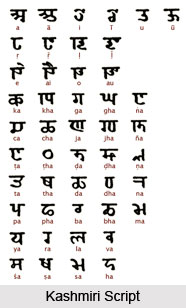 Kashmiri script is of three main types. For the purposes of writing, the three main scripts used are the Sharda, the Nagri and the Persian (Urdu) script. The Persian script is used by all the literate Muslims and till recently by a majority of literate Hindus. It is also the script used by Christian Missionaries in writing books on the holy Bible, specially designed for masses of the country. The Persian script, although fairly constant, is not well suited for illustrating the complicated vowel sounds of the spoken Kashmiri. The Nagri script has as yet a limited use amongst the Hindus, but this alphabet too suffers from the same faults of vowel sounds as Persian.
Kashmiri script is of three main types. For the purposes of writing, the three main scripts used are the Sharda, the Nagri and the Persian (Urdu) script. The Persian script is used by all the literate Muslims and till recently by a majority of literate Hindus. It is also the script used by Christian Missionaries in writing books on the holy Bible, specially designed for masses of the country. The Persian script, although fairly constant, is not well suited for illustrating the complicated vowel sounds of the spoken Kashmiri. The Nagri script has as yet a limited use amongst the Hindus, but this alphabet too suffers from the same faults of vowel sounds as Persian.
The ancient and indigenous script of Kashmiri is Sharda. Being built on the same system and corresponding with it, letter for letter, Sharda is allied to Nagri, but the forms of letters differ greatly. This script, being the mother of Dogri language, Gurmukhi script and Takkari scripts, is more closely allied to this script rather than to Nagri. It is the only perfect script for Kashmiri. But this script is now only used by Jyotishis and Purohits of Kashmir and that too for Panchangs and horoscopes. There is therefore the ominous possibility that this script may become dead and extinct.
Kashmiri, written in Persian script, is sometimes spoken of Muslmani Kashur and that in Nagri as Bhata (Kashmiri Pundits) Kashur. Persian script, with some additional sounds, signs, is being used by some people and the educational and Information media of the Government of Kashmir. The broadcasting system of India too is using and has approved this very script for their broadcasts. But to fit in the additional sound signs in the Persian script seems to be an uphill task and people in general have not responded well so far. This Persian script, with some minor additions, has now got the approval of the State Education Department and the modern writers and printers use it invariably. University of Kashmir has introduced some examinations in Kashmiri. The first Kashmiri Dictionary, which is being published by the Government, now uses this script.



















